Turkmenistan manat
| Turkmenistan manat | |
|---|---|
| Türkmen manady (in Turkmen) | |
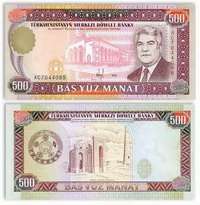 Old 500 manat banknote of the first manat. | |
| ISO 4217 | |
| Code | TMT |
| Denominations | |
| Subunit | |
| 1/100 | tenge (teňňe (in Turkmen)) |
| Plural | The language(s) of this currency does not have a morphological plural distinction. |
| Symbol | T |
| Banknotes | 1, 5, 10, 20, 50, 100, 500 manat |
| Coins | 1, 2, 5, 10, 20, 50 tenge, 1, 2 manat |
| Demographics | |
| User(s) |
|
| Issuance | |
| Central bank | Central Bank of Turkmenistan |
| Website | www.cbt.tm |
| Valuation | |
| Inflation | 8.5% |
| Source | The World Factbook, 2012 est. |
The manat is the currency of Turkmenistan. It was introduced on 1 November 1993, replacing the Russian ruble at a rate of 1 manat = 500 rubles.[1] The ISO 4217 code was TMM, and the manat was subdivided into 100 tenge. The abbreviation m is sometimes used, e.g., 25 000 m is twenty-five thousand manat.
On January 1, 2009, the new manat was introduced with ISO 4217 code TMT at the rate of 5000 old manat to 1 new manat.[2]
Etymology
The word "manat" is borrowed from Persian word "munāt" and the Russian word "монета" ("moneta") meaning "coin".[3] Likewise, 'manat' was the name of the Soviet ruble in both Azeri and Turkmen.
Coins
In 1993, coins were introduced in denominations of 1, 5, 10, 20 and 50 tenge. The 1, 5 and 10 tenge were struck in copper-plated-steel, with the higher denominations in nickel-plated-steel. This first series of coins was short lived as their metal value soon became worth more than their actual face value. After a period of high inflation, new coins of 500 and 1,000 manat were introduced in 1999. All coins of this period had to depict a picture of the president by law.
During the monetary reform of 2009, new coins of 1, 2, 5, 10, 20 and 50 tenge were issued with bimetallic 1 and 2 manats following in 2010. The 1, 2, and 5 tenge are nickel-plated steel while the 10, 20, and 50 tenge are made of brass. Instead of depicting the current head of state the coins feature a map of Turkmenistan with the Independence Tower superimposed in front of it. All circulating coins of Turkmenistan have been minted by the Royal Mint.
 1 tenge coin
1 tenge coin 5 tenge coin
5 tenge coin 10 tenge coin
10 tenge coin
 20 tenge coin
20 tenge coin 50 tenge coin
50 tenge coin
Banknotes
First manat
In 1993, manat notes were introduced in denominations of 1-, 5-, 10-, 20-, 50-, 100 and 500 manat, replacing the Soviet ruble. These were followed by notes for 1,000 manat in 1995 and 5,000 and 10,000 manat in 1996. In 2005, a new series of notes was introduced in denominations of 50-, 100-, 500-, 1,000-, 5,000 and 10,000 manat. All notes, with exception to only the 1 and 5 manat banknotes bear a portrait of former president Saparmurat Niyazov. All Turkmen banknotes are produced by the De La Rue printing and banknote company.
| Banknotes of the Turkmenistan manat (First manat) | |||||||||
|---|---|---|---|---|---|---|---|---|---|
| Image | Value | Dimensions (millimeters) | Main Color | Description | Date of issue | Date of first issue | Watermark | ||
| Obverse | Reverse | Obverse | Reverse | ||||||
| 1 manat | 120 x 60 mm | Orange and red | Ylymlar academy, Aşğabat | Ilarslanyn Yadygarligi mausoleum | 1993 | ||||
| 5 manat | 125 x 62.5 mm | Blue | Bazcylyk Okuw Polytechnic Institute, Aşğabat | Abu Seyidiñ mausoleum | 1993 | ||||
| 10 manat | 133 x 66 mm | Brown | Turkmenistan Relationship building (Aşğabat), President Saparmurat Niyazov | Tekesiñ mausoleum | 1993 | ||||
| 20 manat | 139 x 69 mm | Blue and white | National library (Aşğabat), President Saparmurat Niyazov | Astanababa mausoleum | 1993 1995 |
||||
| 50 manat | 144 x 72 mm | Orange and brown | Soviet Honor monument, President Saparmurat Niyazov | Anew mosque | 1993 1995 |
||||
| 100 manat | Blue and orange | Prezident Köşgi (President’s Palace, Aşğabat), President Saparmurat Niyazov | Sultan Sanjariń mausoleum | 1993 1995 |
|||||
| 500 manat | Red and violet | National theatre (Aşğabat), President Saparmurat Niyazov | Törebeg Hanymyń mausoleum | 1993 1995 |
|||||
| 1,000 manat | Green and red | Prezident Köşgi (President’s Palace, Aşğabat), President Saparmurat Niyazov | National emblem of Turkmenistan | 1995 | |||||
| 5,000 manat | Violet | Prezident Köşgi (President’s Palace, Aşğabat), President Saparmurat Niyazov | National emblem of Turkmenistan | 1996 | |||||
| 10,000 manat | Blue and brown | Prezident Köşgi (President’s Palace, Aşğabat), President Saparmurat Niyazov | National emblem of Turkmenistan | 1996 1999 2000 |
|||||
| 10,000 manat | Blue and brown | Türkmenbaşi Köşgi (Turkmenbashi’s Palace, Aşğabat), President Saparmurat Niyazov | Saparmurat Haji mosque | 1998 1999 |
|||||
| 10,000 manat | Blue and brown | Türkmenbaşi Köşgi (Turkmenbashi’s Palace, Aşğabat), President Saparmurat Niyazov | Neutrality Monument, Ruhyýet Palace, Aşğabat | 2000 | |||||
| 10,000 manat | Light brown | Türkmenbaşi Köşgi (Turkmenbashi’s Palace, Aşğabat), President Saparmurat Niyazov | Monument of Independence and Peace, Aşğabat | 2003 2005 |
|||||
First manat (Second Issue)
In 2005, a new series of manat banknotes was introduced. They had originally been intended to replace the first manat at a fixed rate, with 1000 equal to 1 of the first manat, but the revaluation was postponed and this issue was released to circulate with previous manat issues. The series of notes was introduced in denominations of 50-, 100-, 500-, 1,000-, 5,000 and 10,000 manat. Two new coins were also introduced in only two denominations, 500 and 1,000 manat. Both the first and second issue manat banknotes circulated in tandem until the issue of the Second Manat (revalued) issue in 2009.
| Banknotes of the Turkmenistan manat (First manat, second issue) | |||||||||
|---|---|---|---|---|---|---|---|---|---|
| Image | Value | Dimensions (millimeters) | Main Color | Description | Date of issue | Date of first issue | Watermark | ||
| Obverse | Reverse | Obverse | Reverse | ||||||
| 50 manat | 156 x 78 mm | Violet | President Saparmurat Niyazov | Golden Horse "Yanardag" of the Achalteks | 2005 | ||||
| 100 manat | 156 x 78 mm | Red | President Saparmurat Niyazov | Central Bank building, Aşğabat | 2005 | ||||
| 500 manat | 156 x 78 mm | Brown | President Saparmurat Niyazov | Turkmen jewelry | 2005 | ||||
| 1,000 manat | 156 x 78 mm | Green | President Saparmurat Niyazov | Türkmenbaşi Köşgi (Turkmenbashi’s Palace, Aşğabat) | 2005 | ||||
| 5,000 manat | 156 x 78 mm | Blue | President Saparmurat Niyazov | Türkmenbaşi Köşgi (Turkmenbashi’s Palace, Aşğabat) | 2005 | ||||
Second manat
After hyperinflation significantly devalued the currency, a new manat with a fixed exchange rate was introduced, replacing the old manat on a ratio of 5000 OM = 1 NM. Banknotes in this series were printed in denominations of 1-, 5-, 10-, 20-, 50-, 100, and 500 new manat. As part of an effort by the Turkmen government to dismantle the Niyazov cult of personality and help politically disambiguate the current rule, only the highest valued banknote, 500 manat, bears a portrait of the former leader. The 500 manat notes have not yet been released into circulation. The other denominations feature images of buildings in Ashgabat or technological achievements (TurkmenSat 1) and portraits of Ahmed Sanjar, Oghuz Khan, Magtymguly Pyragy and other figures in Turkmen history.[4]
Images of the third manat.
| Banknotes of the third manat | |||||||||
|---|---|---|---|---|---|---|---|---|---|
| Image | Value | Dimensions (millimeters) | Main Color | Description | Date of issue | Date of first issue | Watermark | ||
| Obverse | Reverse | Obverse | Reverse | ||||||
 |
 |
1 manat | 120 x 60 mm | Light green | Emblem of Turkmenistan; Togrul Beg Türkmen (aka Tugrul Bey) | Beyik Saparmyrat Türkmenbaşynyň Milli Medeniyet Merkezi (National Cultural Centre of Great Saparmurat Turkmenbashi), Aşğabat | 2012 | January 1, 2009 | Togrul Beg Türkmen, electrotype Crescent moon, five five-pointed stars and 1 |
| 1 manat | 120 x 60 mm | Light green | Emblem of Turkmenistan; Togrul Beg Türkmen (aka Tugrul Bey); 5th Asian Indoor & Martial Games | Ashgabat International Airport (Aşgabadyň Halkara Howa Menzili), Aşğabat; TürkmenÄlem Sat, or TurkmenSat 1 | 2017 | January 1, 2017 | Togrul Beg Türkmen, electrotype Crescent moon, five five-pointed stars and 1 | ||
 |
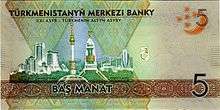 |
5 manat | 126 x 63 mm | Tan | Emblem of Turkmenistan; Soltan Sanjar Türkmen | Garaşsyzlyk Binasy (Independence monument), Bitaraplyk Binasy (Neutrality monument), Aşğabat | 2012 | January 1, 2009 | Soltan Sansar Türkmen, electrotype Crescent moon, five five-pointed stars and 5 |
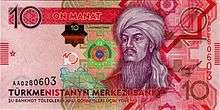 |
 |
10 manat | 132 x 66 mm | Red | Emblem of Turkmenistan; Magtymguly Pyragy | Central Bank building, Aşğabat | 2012 | January 1, 2009 | Magtymguly Pyragy, electrotype Crescent moon, five five-pointed stars and 10 |
 |
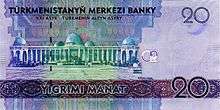 |
20 manat | 138 x 69 mm | Purple | Emblem of Turkmenistan; Görogly Beg Türkmen (aka Köroğlu) | Ruhyýet Köşgi (Palace of Spirituality), Aşğabat | 2012 | January 1, 2009 | Görogly Beg Türkmen, electrotype Crescent moon, five five-pointed stars and 20 |
 |
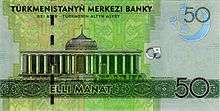 |
50 manat | 144 x 72 mm | Cyan | Emblem of Turkmenistan; Gorgut Ata Türkmen (aka Dede Korkut) | Türkmenistanyň Mejlisi (National Assembly of Turkmenistan), Aşğabat | 2009 | January 1, 2009 | Gorkut Ata Türkmen, electrotype Crescent moon, five five-pointed stars and 50 |
 |
 |
100 manat | 150 x 75 mm | Blue | Emblem of Turkmenistan; Oguz Khan Türkmen | "Oguzhan" Köşkler Toplumy (Oguzkhan Palace), Aşğabat | 2014 | January 1, 2009 | Oguz Khan Türkmen, electrotype Crescent moon, five five-pointed stars and 100 |
 |
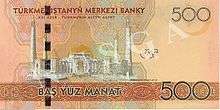 |
500 manat | 156 x 78 mm | Gold | Emblem of Turkmenistan; Saparmurat Niyazov | Kypçak Metjidi (Kipchak Mosque) | 2009 | TBA | President Saparmurat Niyazov, flag, and electrotype 500 |
| Current TMT exchange rates | |
|---|---|
| From Google Finance: | AUD CAD CHF EUR GBP HKD JPY USD RUB CNY |
| From Yahoo! Finance: | AUD CAD CHF EUR GBP HKD JPY USD RUB CNY |
| From XE: | AUD CAD CHF EUR GBP HKD JPY USD RUB CNY |
| From OANDA: | AUD CAD CHF EUR GBP HKD JPY USD RUB CNY |
| From fxtop.com: | AUD CAD CHF EUR GBP HKD JPY USD RUB CNY |
See also
Notes
- ↑ Linzmayer, Owen (2012). "Turkmenistan". The Banknote Book. San Francisco, CA: www.BanknoteNews.com.
- ↑ "Turkmenistan's 5000 manat to equal 1 manat after denomination". 2008-09-06.
- ↑ "Definition of Manat". Dictionary by Merriam-Webster. Retrieved 19 March 2018.
- ↑ Манаты без Туркменбаши, Аскар Турсунбаев, Гундогар (in Russian)
References
- Krause, Chester L.; Clifford Mishler (1991). Standard Catalog of World Coins: 1801–1991 (18th ed.). Krause Publications. ISBN 0873411501.
- Pick, Albert (1994). Standard Catalog of World Paper Money: General Issues. Colin R. Bruce II and Neil Shafer (editors) (7th ed.). Krause Publications. ISBN 0-87341-207-9.
External links
- New currency samples - images of the new 2009 Manat
- Coins of Turkmenistan at CISCoins.net
| Preceded by: Russian ruble Reason: independence from Soviet Union Ratio: 1 first manat = 500 rubles |
Currency of Turkmenistan November 1, 1993 – December 31, 2008 |
Succeeded by: Second manat Reason: inflation Ratio: 1 second manat = 5000 first manat |
| Preceded by: First manat Reason: inflation Ratio: 1 second manat = 5000 first manat |
Currency of Turkmenistan January 1, 2009 – |
Succeeded by: Current |